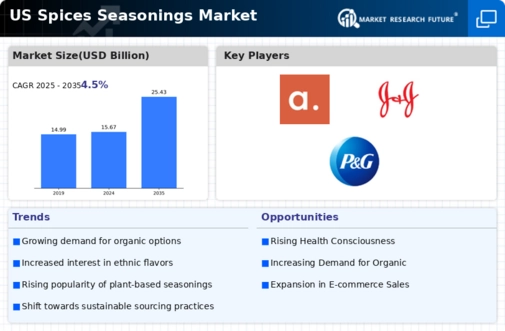Increased Focus on Flavor Innovation
The spices seasonings market is witnessing a heightened emphasis on flavor innovation as companies strive to differentiate their products. With consumers becoming more discerning about taste, manufacturers are investing in research and development to create unique flavor profiles that cater to evolving palates. This trend is evident in the introduction of new spice blends and fusion flavors that combine traditional spices with contemporary culinary influences. Market data indicates that innovative flavor offerings can lead to a sales increase of up to 30% for brands that successfully capture consumer interest. As competition intensifies, the ability to offer distinctive and appealing flavors will likely be a critical driver for growth in the spices seasonings market.
Rising Demand for Natural Ingredients
The spices seasonings market is experiencing a notable shift towards natural and organic ingredients. Consumers are increasingly seeking products that are free from artificial additives and preservatives. This trend is driven by a growing awareness of health and wellness, with many individuals opting for clean-label products. According to recent data, the organic spices segment has seen a growth rate of approximately 15% annually, indicating a robust demand for natural options. As consumers prioritize transparency in food sourcing, manufacturers in the spices seasonings market are adapting their offerings to include more organic and sustainably sourced ingredients. This shift not only caters to health-conscious consumers but also aligns with broader environmental concerns, potentially enhancing brand loyalty and market share for companies that embrace these practices.
Culinary Experimentation and Home Cooking
The spices seasonings market is benefiting from a surge in culinary experimentation among consumers. As more individuals engage in home cooking, there is an increased interest in diverse flavors and unique spice blends. This trend is particularly pronounced among millennials and Gen Z, who are eager to explore global cuisines. Data suggests that the demand for specialty spices has risen by approximately 20% in recent years, reflecting a shift towards more adventurous cooking. Retailers are responding by expanding their spice offerings, introducing new blends and international flavors to meet consumer preferences. This growing enthusiasm for cooking at home not only drives sales in the spices seasonings market but also encourages consumers to invest in higher-quality products, further enhancing the market's growth potential.
Influence of Food Trends and Social Media
The spices seasonings market is significantly influenced by emerging food trends and the pervasive impact of social media. Platforms such as Instagram and TikTok have become vital in shaping consumer preferences, with food influencers showcasing innovative recipes that often highlight unique spices and seasonings. This visibility has led to a marked increase in the popularity of certain spices, with sales of exotic varieties rising by approximately 25% in the past year. As consumers seek to replicate trending dishes at home, the demand for specific spices is likely to continue growing. Consequently, brands in the spices seasonings market are increasingly leveraging social media marketing strategies to engage with consumers, promote their products, and capitalize on the viral nature of food trends.
Sustainability and Ethical Sourcing Initiatives
The spices seasonings market is increasingly influenced by sustainability and ethical sourcing initiatives. Consumers are becoming more conscious of the environmental and social impacts of their purchasing decisions, leading to a demand for products that are sourced responsibly. Companies that prioritize sustainable practices, such as fair trade sourcing and eco-friendly packaging, are likely to resonate with this growing consumer base. Recent surveys indicate that approximately 70% of consumers are willing to pay a premium for sustainably sourced spices. This trend not only reflects a shift in consumer values but also presents an opportunity for brands in the spices seasonings market to enhance their reputation and build trust with their customers. As sustainability becomes a key differentiator, companies that embrace these initiatives may gain a competitive edge.














Leave a Comment